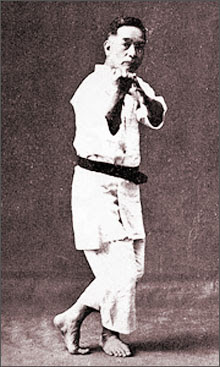Note: This article has since been updated and rewritten and is available here.
A good starting point for the understanding of any kata is to examine its name. With Shotokan that can mean looking at the name changes introduced by Sensei Funakoshi in the 1930s and also to research the kata's original - or at least Okinawan - name as well.
There is a slightly different angle as far as Kanku-sho goes because it is named after its 'parent kata', Kanku (originally Kushanku), so the kata itself does not necessarily have a direct influence on the name. That does, however, lead to another area of study altogether, namely the kata's association, if any, with its parent - but that will be for another time.
Despite all that, let's look at the name. Here are the kanji for Kanku-sho: 観空小
観 is for kan meaning view, look or appearance.
空 is for ku meaning sky, empty or void. You will probably recognise this as the kanji also for kara in karate - empty hand.
小 is for shou meaning little or small.
Put together Kanku-sho means 'viewing the sky' or 'viewing emptiness' - small version. In relation to Kanku, Funakoshi, in Karate-do Kyohan, said:
"I have given it [the] name Kan-ku, sky-gazing, since at the beginning of the kata, there is a movement of your hands coming together with you looking up at the sky through them."
It has also been mentioned that 'looking at the sky' is akin to 'looking into the void' with the double meaning similar to that which Funakoshi intended with the change from Chinese Hand to Empty Hand.
From Karate-do Nyumon:
"Just as an empty valley can carry a resounding voice, so must the person who follows the way of karate make himself void or empty by ridding himself of all self-centredness and greed. Make yourself empty within, but upright without. This is the real meaning of 'empty' in karate."
This ties in with the zen concept of mushin (no mind), or Bankei's 'unborn mind', and is the state a student should enter into during mokuso and, in fact, training in general.
So does the meaning have any bearing on Kanku-sho? Obviously the deeper meaning does - that applies to all practice of karate. As for the physical aspect, it has been suggested that the haishu-uke, just before the jumping crescent and back kick, is the sho equivalent of Kanku-dai's opening move - you slowly extend your arm to block with the back of your hand to jodan level - thus 'looking at the sky'.
It does fit, though not as poetically as Kanku-dai, but has that technique been recruited to fit the concept after the fact, or was it created in order to serve it (the jodan haishu uke is not present in the original form of Kushanku-sho, it is a Shotokan development). Remember that Funakoshi changed the kata names to make them easier, or more palatable, for the Japanese (even Okinawans didn't necessarily have consensus on the meanings of the their kata names), and his new names reflected the character of the kata in order to make more sense as they were introduced to a wider public.
Furthermore Kanku was originally called Kushanku (or Koshokun), named for a Chinese official who visited Okinawa in 1756, and had nothing to do with looking at the sky. Kanku-sho is merely inherited from Kushanku-sho, so is doubly removed in that its name is only there to connect it to its parent kata, so it had to be updated along with Kanku (aka Kanku-dai).
In conclusion, the name doesn't tell us a lot about the kata itself other than it is connected to an earlier kata and the jodan haishu uke may have been included in the Shotokan version with the name in mind - or not. The interesting thing will be to see how and why this is a 'small' version of its big brother.







